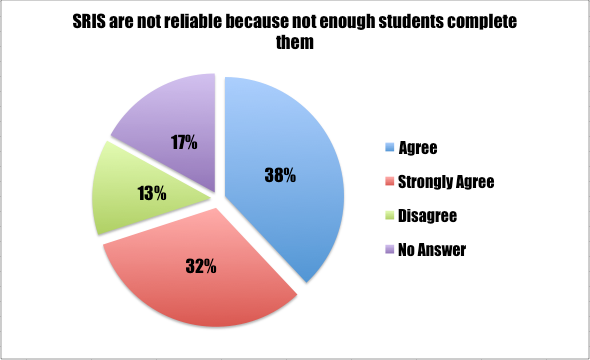By Gloria Petit
The end of every academic semester marks the busiest time for students, from final projects to final exams. In addition, students are asked to carve out even more time to evaluate their professors through an online survey.
Next week, the office of institutional research will email students with the weblink to rate their instructors and courses.
The university switched from the paper form of Student Rating of Instructor Surveys, or SRIS, to the digital form in Fall 2010. Despite the university’s attempt to offer an easier process of collecting evaluations, faculty raised questions of survey efficiency in the spring during a Faculty Senate meeting.
During the meeting, faculty expressed two major concerns on the topic of online surveys: lower participation by students and misrepresentations on the measurements.
“The first thing me and my colleagues discussed was the low percentage of returns,” said Edward Westermann, associate professor of history and Faculty Senate president. “Those low percentage rates would mean that it becomes a nonrepresentative sample.”
According the office of institutional research, the spring’s overall response rate for SRIS landed at 33.95 percent.
Students in assistant sociology Professor Vicky Elias’ SOCI 4382, Research Methods, class studied the efficiency for online forms by surveying faculty. Feedback presented to Faculty Senate showed results of faculty finding inaccuracy with online forms of SRIS.
“The faculty felt like it wasn’t absolutely fair and felt like they weren’t getting the full range of feedback,” Elias said.
The class sent 211 surveys to faculty and received 75 completed surveys. The class identified eight key points, ranging from the reliability of SRIS to whether students are qualified to answer questions.
Results showed that 91 percent of faculty “reviewed or skimmed” SRIS as a way to improve courses. Faculty want more feedback overall.
Faculty expressed that they prefer another survey delivery method in order to increase participation. They found the online system as the least effective method of delivery, as opposed to paper forms, scantrons or time in a computer lab.
Another point referred to the reliability of SRIS. Feedback showed that 70 percent of the participants agreed or strongly agreed that low percentage of student cooperation makes surveys unreliable.
While faculty have questioned the efficiency of online SRIS, some faculty feel having online forms of these surveys do have positive benefits.
According to Tracey Hurley, dean of the College of Business, online forms save time and money.
The university pays $5,400 yearly to a private sector company from Colorado called EvaluationKit to collect all data and store it in a private database. As soon as results of surveys process, the university then has the ability to pull data and conduct research to give automatic feedback to professors.
When the university did usethe pencil and paper form of the SRIS, the process for collecting those SRIS created an extensive data collection. In addition to the longer wait for survey data, faculty had to wait much longer for students to fill these surveys out.
While the question of the efficiency of these online surveys still remains, there is certainty in faculty continuing to encourage students to participate in filling out SRIS.
As a way to boost participation, Elias has helped put together a “You Speak, We Listen” strategy to encourage students. Elias sent numerous fliers throughout the school to remind students to fill out their course evaluations.
While Elias’ strategy may promote student participation, a few students have hopes to see the university make the switch back to scantron forms of SRIS.
Biology junior Jessica Buitron transferred from the Alamo Colleges, and recalls the benefits of scantron forms of SRIS.
“At the Alamo Colleges, they had us do paper forms of the evaluations,” Buitron said. “In a way, the professors were able to get more feedback by doing so.”
Psychology senior Elizabeth Reyna remembers when the university made the switch from the scantron to online surveys.
“I was here when the university made the switch from paper forms to online forms, and I remember students not participating as much afterward,” Reyna said. “We would benefit from switching back because we would get more class time to fill out the surveys.”







